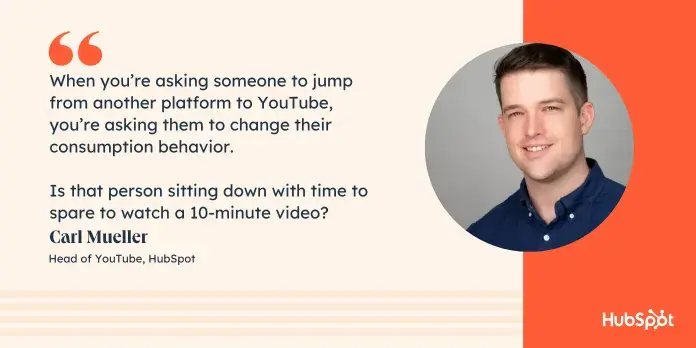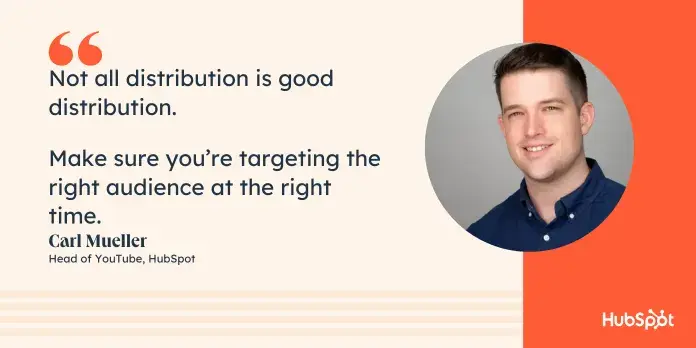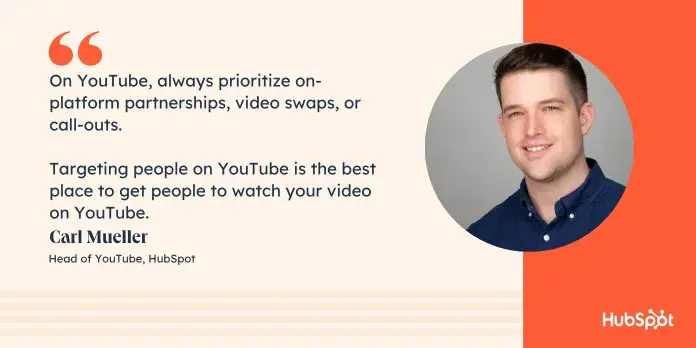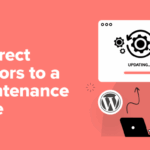When I first heard how HubSpot’s YouTube staff had increased a channel’s views by over 400%, I begged permission to share the story. (I’m no longer willing to humiliate myself on your behalf.)
It’s a lesson that applies to all promotional content, and one that I assure you, you won’t hear again anywhere else.
Can you? Not all distributions are great distributions. And this one fits yours.
Below, I talk to our YouTube head about how and why to reduce All external distribution to tell the truth higher our YT power. And his advice for when you should consider going for the axe, too.
The Highway to the Decreasing Block
When Carl Mueller joined us as HubSpot’s YouTube lead earlier this year, he noticed that one of our YT channels had a topic that the others didn’t. If a video was even six minutes long, most of the target audience had tuned out after just a minute or two.
Although, to be fair, it’s still longer than it took my son to complete Fantastic Mr. Fox.
Carl has been producing videos for over 10 years for names like Business Insider and Morning Brew. That is to say, where media and promotion merge, Carl knows his s**t.
So when he says the issue wasn’t the subject matter of the content, I know he’s not just trying to avoid hurt feelings.
“I got here in late February and the first thing I did was look at our content topic from a high-quality perspective,” he says. “Instead I looked at the metrics and the numbers were unusually low. I don’t think the metrics reflected the norm for films.”
But if the problem wasn’t the subject of the content, what once was?
The verdict comes from within the House.
As Carl investigated the issue, he noticed that about 90% of the views for this particular channel were coming from external properties. This includes Facebook, Instagram, blogs, newsletters, everything with the exception of Italian:
“What I’ve noticed is that when you ask someone to switch from any other platform to YouTube, you’re asking them to change their consumption behavior,” he explains. “Is that specific individual sitting down with free time to watch a 10-minute video?”
The strategy to do this is carefully based on the platform you are starting from.
And about 90% of those external views came from The Hustle e-newsletter.
“Which, at first glance, makes a lot of sense. It seemed like excellent targeted distribution. But it meant that most of our common audience was once coming from the e-newsletter.”
Sounds like the opposite of an argument, right? As I not-so-subtly mentioned earlier, The Hustle has a target audience of over 2.5 million and engagement fees that are above the industry average. It’s the kind of target market that most marketers would want {industry} a body segment to get in front of. (And I mean a useful body segment. Not just a pinky toe.)
And in the vast majority of cases, they would be right. The Hustle is an absolute catapult for content material, regularly using tens of hundreds of thousands of views on blogs, short films, and content materials. So why didn’t that work of art get here?

Carl explains it like this:
“The e-newsletter goes out at, what, 5:30 in the morning? Others open it in bed.” They click on a video, “watch for a few minutes and then die.”
Or they save it for later and then forget about it in a sea of cards. (Guiltyy …
“For a lot of people who were in their shoes, are you going to watch that full video? For me, the answer is no,” Carl laughs. “Maybe every once in a while if I’m lying on my couch. But if the average e-newsletter reader isn’t ready to watch a long video, that’s a lot of bad retention metrics.”
For this otherwise extraordinarily engaged market target, the loyalty value once hovered around 20-30%.
Let’s do some quick math. What’s similar when 90% of your target market has a 20% retention value? An unfortunate algorithm.
As Carl says, “YouTube won’t promote your content if your target audience isn’t watching it.”
We would have preferred surgery, right away.
Make the decrease
“We have decided, on an experimental basis, to suspend all direct external distribution,” says Carl.
Alternatively why? All distribution and no longer simply a mismatched target market?
“We needed to first see if we had a core market on YouTube. We needed to serve movies more efficiently to our subscriber base and see within the game that they were liked.”
And it worked. Better than Carl had expected.
“I warned everyone that we were going to get worse before we got better. A few thousand confident views were vanishing,” Carl recalls. “But one time it was incredibly fast. The main video after the change got 27,000 views. A couple of movies later we had one that got 300,000. Then 450,000.”
Approximately 90 days after we stopped distribution, the channel’s average views and watch time increased by 420%, while our subscriber count increased by 257%.
This goes against everything I’ve learned about content promotion, where more distribution equals more views. What’s up, Carl?
“It’s getting the right amount of luck. If something does really well, YouTube is much more likely to promote it in the next video.”
A target market built on YouTube is capable of watching a YouTube video. And if most of your target audience is watching most of your content material, it sends positive signals to the YT algorithm. YouTube then serves your films to a much larger target market and a virtuous circle is born.
“Not all distribution is great distribution,” says Carl. “This is commonplace across all channels and content. Make sure you’re targeting the target market that’s coming in at the right time.”

Ask your doctor if stopping dosing is right for you.
And this is where I paused, because I realized that some of you are starting to get nervous about the idea of DIY.
I asked Carl what he would say to readers who are now interested in discontinuing their distribution.
“Make sure your channel is in the same circumstances as our channel. It has relied heavily on external distribution and events with low viewership. If you have that combination, then those uninvolved external viewership are probably impacting your power.”
So, to be clear: for many who Not have low engagement, it’s likely that your distribution is doing its thing and stopping it won’t help you scale any further.
Likewise, if the majority of your views are not coming from an external distribution, then it is almost certain that this is no longer the cause of low metrics.
Alternatively, Carl will never let you go away empty-handed again. Here are some ideas for everyone:
1. Consider behavior patterns when sharing something with an imaginable target market.
This is a valid tip for any type of promotion, not just video promotion.
Before distributing your content through any channel, consider the consumption behavior of your target audience.
Am I in the right place to share a post on social media? Download a PDF? Listen to a podcast?
“There may also be value in external distribution, but on the other hand you need to make sure it’s distributed to the right people, at the right time, and at the right level within the content lifecycle.”
2. Search for distribution on the platform.
“On YouTube, I could always prioritize on-platform partnerships, video exchanges, or call-outs. Everything for Others on YouTube is the best place to get other people to check out your video on YouTube.”
And this usually applies to many types of content. Consider, for example, that you are probably looking for TikTok audiences on TikTok. Or that newsletter readers are regularly willing to become blog readers. (And, as if by magic, there you are.)

3. Optimize for the platform, no longer for the distribution channel.
“Let YouTube do its job in a heartbeat,” Carl advises. “If it stops working, change your thumbnails, change your titles. Do whatever it takes to optimize for YouTube.”
On the other hand, not to be a broken record, again, this applies to any type of content or platform. Optimize first for search, social, or wherever your target market necessarily finds your content.
“And if that doesn’t work anymore, then it might be worth taking the risk of trying it in other places.”
4. Set clear expectations.
If your target market clicks on a link without realizing that it translates to a video, many more people will abandon ship. The same goes for long-form written content.
To avoid this, you need to set expectations about what will happen during the game.
“If we share, because there might be value in sharing movies with the e-newsletter target market, let’s make it very clear that this is a video,” he then switches to a mock-stern voice. “All caps. WATCH THE VIDEO. You might as well leave. ARE YOU READY?”
Now you are.
How to See YouTube Reviews in HubSpot
Hub Enterprise buyers who promote and advertise can actually transfer their wisdom about the power of YouTube directly into HubSpot, so they can see all their good fortune in one place.
You’ll be ready to discover personalized stories about watch time, views, shares, subscriber count, engagement, and more, allowing you to be the Carl Mueller of your company.
First, you will need to connect your YT account to HubSpot.
- In HubSpot, click on settings icon inside what is probably the smartest navigation bar.
- Select Promotion and advertising Then Social.
- Click on on on Connect account inside probably the most intelligent correct.
- Select YouTube Criticisms inside the box that opens.
- Select the YouTube account you want to connect to.
- Evaluate the permissions and click on Allow.
Now that you’re fully connected, here’s how you can easily access your stories:
- Sail once again towards Promotion and advertising Then Social. (Besides the fact that you’re already there from the main segment. So skip this segment.)
- Click on the tab that says Analyze.
- Click on the drop down menu that says All accounts and make sure YouTube is selected.
- Use filters by date range, ad campaign, and so on, depending on your preferred topic.

wordpress seo
[ continue ]
wordpress Maintenance Plans | wordpress hosting
Learn more







